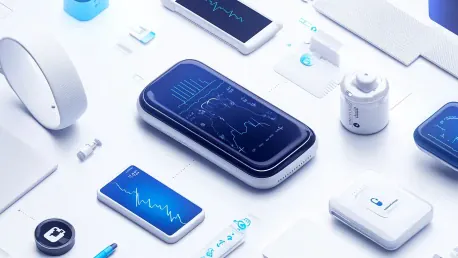Wearable technology has come a long way, evolving from simple fitness trackers to sophisticated devices that monitor various aspects of our health and lifestyle. The Consumer Electronics Show (CES) in Las Vegas has become a hotspot for unveiling the latest advancements in this field. In 2025, wearable tech is not just about convenience; it’s about revolutionizing how we manage our health and daily activities, offering groundbreaking innovations that are set to transform our daily routines.
Innovations in Wearable Health Monitoring
Smart Rings: A New Era of Convenience
Among the trailblazing advancements is the Circular Ring 2, a smart ring that distinguishes itself with its revolutionary digital-sizing technology. Traditionally, users had to use physical sizing kits to ensure a perfect fit, which often meant delays and additional costs. However, Circular Ring 2 changes the game by leveraging a smartphone’s camera to precisely measure the user’s ring size. This method not only eliminates the hassle of mailing kits but also streamlines the purchasing process significantly, allowing a seamless transition from selection to wear. This innovation underlines the continuing trend toward more user-centric designs in the wearable tech market.
Expected to be available in early 2025, the Circular Ring 2 carries a price tag of $380, reflecting its advanced features and superior user-friendly design. This smart ring stands as a testament to how technology can be both functional and accessible, amalgamating sophisticated health tracking capabilities in a compact form factor. From activity levels to sleep patterns, the range of data it can gather empowers users to make informed decisions about their health and wellness. Such advancements in smart ring technology show how miniaturization and smart integration can elevate the user’s experience.
Sleep Wearables: Enhancing Rest and Recovery
Sleep monitoring has made leaps and bounds, with wearables like the Frenz Brainband leading innovations aimed at optimizing rest and enhancing cognitive function. Equipped with artificial intelligence, the Frenz Brainband offers comprehensive tracking capabilities, monitoring EEG brain signals, eye movements, facial expressions, and heart rate to provide a detailed analysis of sleep patterns. Its real-time brainwave tracking is instrumental in helping users achieve better sleep through personalized insights that promote cognitive behavioral therapy for insomnia (CBT-i) and focused mental states.
The Frenz Brainband’s robust functionality has positioned it as a frontrunner in the sleep wearable segment, earning the CES Innovation Award in recognition of its potential to drastically improve users’ quality of life. This AI-powered headband underscores a practical application of cutting-edge technology geared toward enhancing overall well-being. For those struggling with sleep disorders or seeking to balance demanding lifestyles, such tools present a viable solution. The detailed data provided enables users to tailor their sleep schedules and habits, paving the way for healthier living through informed decision-making.
Luxury Meets Technology
High-End Wearables: The Ultrahuman Ring Rare
At the intersection of luxury and technology, the Ultrahuman Ring Rare emerges as a prime example of combining high-end materials with functional health tracking capabilities. These rings, available in opulent finishes such as 18-karat gold and platinum, cater to consumers who do not want to compromise style for functionality. Despite their luxurious exterior, the internal software and sensors remain consistent with previous models, offering comprehensive monitoring of sleep, physical activity, and recovery.
The Ultrahuman Ring Rare epitomizes a burgeoning trend where wearable technology is not only about utility but also about making a statement. It caters to a niche market that places significant emphasis on aesthetics without sacrificing advanced health monitoring. This blend of luxury and technology speaks to a broader shift in consumer preferences, where the demand for stylish yet tech-savvy accessories is on the rise. It indicates an evolving market where technology seamlessly integrates into everyday wear while enhancing lifestyle through data-driven insights.
Smart Glasses: A Blend of Fashion and Function
Advancements in smart glasses have led to products that are not only functional but also stylish, blending seamlessly into the wearer’s daily life. Halliday smart glasses exemplify this evolution by offering a lightweight design that radically departs from traditional bulky lenses. Utilizing an advanced optical module, these smart glasses project critical information directly into the wearer’s view, effectively merging digital convenience with universal appeal. This design makes them practical for everyday use, ensuring that users have access to essential information at a glance without disrupting their look.
Halliday’s approach to smart glasses reflects a significant leap forward in wearable technology, emphasizing user convenience and comfort. As these glasses become an integral part of the user’s routine, they offer critical functionalities such as navigation, real-time notifications, and other dynamic displays. This approach to design makes it easier for users to integrate wearable tech into their day-to-day lives, enhancing productivity without adding unnecessary complexity. The fusion of fashion and function offered by these smart glasses demonstrates how wearables are continually evolving to meet the demands of modern lifestyles.
Bridging the Gap Between Consumer Tech and Healthcare
Continuous Glucose Monitors: Accessible Health Tracking
The realm of health monitoring has seen significant advancements with the introduction of continuous glucose monitors (CGMs) by companies such as Abbott and Dexcom. These monitors are designed to offer accessible glucose tracking to a broader audience. Unlike traditional glucose monitors, Abbott’s Lingo targets individuals who do not have diabetes but are health-conscious and want to monitor their glucose levels. On the other hand, Dexcom’s Stelo is specifically designed for those with prediabetes or Type 2 diabetes, providing them with a practical tool for managing their condition. These over-the-counter solutions are affordably priced, reflecting a shift towards making health tracking technology more accessible to the masses.
The accessibility and user-friendly interface of these CGMs signify a democratization of health tech, encouraging proactive health management among a wider demographic. These devices cater to the growing awareness and need for regular health check-ups, empowering users with real-time data to make informed choices. The implications of such technology extend beyond individual health benefits, potentially easing the burden on healthcare systems through early detection and management of conditions.
Cardio Check-Up: Professional Health Insights
Within the ecosystem of wearable tech, Withings has unveiled its Cardio Check-Up feature aimed at bridging the gap between consumer-collected heart health data and its applicability in professional healthcare. Exclusively available to Withings+ members, this innovative service allows heart health data gathered by the wearable to be sent directly to a board-certified cardiologist. The cardiologist reviews the data and provides detailed feedback within a 24-hour window, offering users actionable insights into their cardiac health. This feature essentially transforms consumer-facing health tools into reliable medical resources.
By providing a direct channel to professional healthcare, Withings’ Cardio Check-Up redefines the utility of wearables in personal health management. It exemplifies how technology can enhance traditional healthcare services, making expert insights more accessible and timely. This innovation represents a crucial step toward comprehensive health monitoring, empowering users to take immediate action based on professional evaluation. Users benefit from the convenience of at-home monitoring coupled with the reassurance of expert analysis, making it a robust solution in proactive health care.
Addressing User Convenience and Battery Life
Extended Battery Life: The Luna Ring Gen 2.0
Battery life continues to be a significant pain point for many wearable devices, and the Luna Ring Gen 2.0 has risen to this challenge by offering an impressive 30-day battery life. This substantial extension from the typical seven to eight days significantly enhances user convenience, allowing continuous monitoring of health metrics without the frequent need to recharge. This feature makes the Luna Ring Gen 2.0 an attractive option for those who require reliable, uninterrupted health tracking.
The extended battery life of the Luna Ring Gen 2.0 is a significant advancement in wearable tech, addressing one of the primary concerns of users. By reducing the need for frequent recharging, this innovation ensures that the device can seamlessly integrate into the user’s lifestyle. This is particularly beneficial for those who rely on consistent health data to manage their well-being. The Luna Ring Gen 2.0 exemplifies how extended battery capabilities can enhance the user experience, making health tracking more convenient and efficient.
Garmin Instinct 3 Series: Designed for Athletes
The Garmin Instinct 3 series represents a significant advancement in smartwatches tailored for athletes, offering features specifically designed to meet their rigorous demands. These rugged smartwatches are equipped with built-in flashlights, scratch-resistant glass, and extended battery life, ensuring they can withstand the challenges of outdoor activities. Additionally, they come with advanced health-monitoring sensors, providing athletes with accurate data to track their performance and physical condition.
Designed with endurance and performance in mind, the Garmin Instinct 3 series stands out as a reliable companion for runners, cyclists, and other athletes. These devices offer a comprehensive set of tools that cater to the specific needs of users, including detailed activity tracking and health metrics. Whether on a challenging trail or an intense training session, these smartwatches provide the durability and functionality required by athletes. The Garmin Instinct 3 series exemplifies the integration of advanced technology into wearable devices, enhancing performance through reliable data.
Unique Innovations in Wearable Tech
Blackbees Bebird EarSight Flow: Hygiene Meets Technology
Wearable technology has significantly progressed, transitioning from basic fitness trackers to advanced devices capable of monitoring multiple facets of our health and lifestyle. The annual Consumer Electronics Show (CES) in Las Vegas has become a premier event for showcasing the newest developments in this arena. By 2025, wearable tech transcends mere convenience; it represents a revolution in how we oversee our health and manage our daily activities. These advanced gadgets offer groundbreaking innovations, enhancing our capability to monitor vital signs, track exercise, and even manage stress levels. Wearable devices are no longer just accessories; they are becoming integral tools that provide real-time medical data, helping to predict and prevent health issues. Advances such as smartwatches, health-monitoring clothing, and even smart glasses demonstrate the potential to transform our everyday lives. The future of wearable technology is poised to integrate seamlessly into our daily routines, making us more connected, informed, and proactive about our overall well-being.









